
Pergolide mesylate salt
CAS No. 66104-23-2
Pergolide mesylate salt( LY127809 | NSC 319773 )
Catalog No. M15516 CAS No. 66104-23-2
PERGOLIDE MESYLATE is a long-acting dopamine agonist which has been used to treat parkinson disease and hyperprolactinemiabut withdrawn from some markets due to potential for heart valve diseases.
Purity : >98% (HPLC)
 COA
COA
 Datasheet
Datasheet
 HNMR
HNMR
 HPLC
HPLC
 MSDS
MSDS
 Handing Instructions
Handing Instructions
| Size | Price / USD | Stock | Quantity |
| 5MG | 42 | In Stock |


|
| 10MG | 60 | In Stock |


|
| 25MG | 105 | In Stock |


|
| 50MG | 168 | In Stock |


|
| 100MG | Get Quote | In Stock |


|
| 200MG | Get Quote | In Stock |


|
| 500MG | Get Quote | In Stock |


|
| 1G | Get Quote | In Stock |


|
Biological Information
-
Product NamePergolide mesylate salt
-
NoteResearch use only, not for human use.
-
Brief DescriptionPERGOLIDE MESYLATE is a long-acting dopamine agonist which has been used to treat parkinson disease and hyperprolactinemiabut withdrawn from some markets due to potential for heart valve diseases.
-
DescriptionPERGOLIDE MESYLATE is a long-acting dopamine agonist which has been used to treat parkinson disease and hyperprolactinemiabut withdrawn from some markets due to potential for heart valve diseases.(In Vitro):Pergolide (10 nM-50 μM) treatment dose-dependently inhibits H2O2-induced cell death in SH-SY5Y neuroblastoma cells. Pergolide protects SH-SY5Y neuroblastoma cells from cell death specifically induced by H2O2, acting in very low concentrations (nanomolar range) and in very early stages of the neurotoxic intracellular process.(In Vivo):Pergolide (0.3 mg/kg; intraperitoneal injection; daily; 11 days) treatment reduces the number of working/reference memory errors a 6-OHDA-induced rat model of Parkinson's disease. Pergolide facilitates spatial memory and improves brain oxidative balance .
-
In VitroPergolide (10 nM-50 μM) treatment dose-dependently inhibits H2O2-induced cell death in SH-SY5Y neuroblastoma cells. Pergolide protects SH-SY5Y neuroblastoma cells from cell death specifically induced by H2O2, acting in very low concentrations (nanomolar range) and in very early stages of the neurotoxic intracellular process. TCell Viability Assay Cell Line:SH-SY5Y cells Concentration:0.01 μM, 0.1 μM, 0.5 μM, 1 μM, 5 μM, 10 μM, 50 μM Incubation Time:Pretreated for 2 hours Result:Dose-dependently inhibited H2O2-induced cell death in SH-SY5Y neuroblastoma cells.
-
In VivoPergolide (0.3 mg/kg; intraperitoneal injection; daily; 11 days) treatment reduces the number of working/reference memory errors a 6-OHDA-induced rat model of Parkinson's disease. Pergolide facilitates spatial memory and improves brain oxidative balance . Animal Model:Wistar rats (200-250 g) induced with 6-hydroxydopamine (6-OHDA) Dosage:0.3 mg/kg Administration:Intraperitoneal injection; daily; 11 days Result:A reduced number of working/reference memory errors was observed. And significant decreased of MDA level.
-
SynonymsLY127809 | NSC 319773
-
PathwayEndocrinology/Hormones
-
Target5-HT Receptor
-
Recptor5-HT receptor| Adrenergic receptor| Dopamine receptor
-
Research AreaNeurological Disease
-
Indication——
Chemical Information
-
CAS Number66104-23-2
-
Formula Weight410.59
-
Molecular FormulaC20H30N2O3S2
-
Purity>98% (HPLC)
-
SolubilityDMSO 10 mg/mL;Water 82 mg/mL
-
SMILES[H][C@@]1(N(CCC)C[C@H](CSC)C[C@@]12[H])CC3=CNC4=C3C2=CC=C4.CS(=O)(O)=O
-
Chemical Name8-beta-((Methylthio)methyl)-6-propylergoline methanesulfonate
Shipping & Storage Information
-
Storage(-20℃)
-
ShippingWith Ice Pack
-
Stability≥ 2 years
Reference
1.Fuller RW, et al. J Pharm Pharmacol. 1985 Apr;37(4):268-70.
molnova catalog



related products
-
Sevoflurane
Sevoflurane, a noncompetitive inhibitor of 5-HT3 receptor, acts as a low-soluble inhalation anesthetics.
-
Hesperetin
Hesperetin is a bioflavonoid and, to be more specific, a flavanone.
-
SB 258719
SB 258719 is a selective antagonist of 5-HT7 receptor with pKi of 7.5.



 Cart
Cart
 sales@molnova.com
sales@molnova.com


